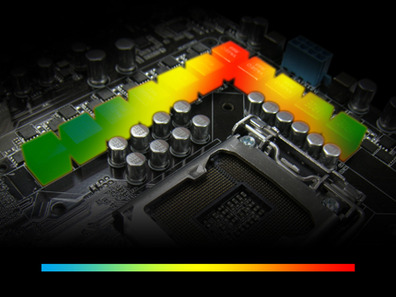
We’ve previewed one of Asus’ upcoming P55 boards, the P7P55 Deluxe, taking a look at its overall layout, heatsinks and ports. We recently had a chance to catch up with the Asus design team to talk about the board’s power management design.
The P7P55D features a new design – branded ‘hybrid phase’, which adds a ‘T.Probe’ chip to a 16-phase power design to provide increased reliability by actively managing the VRMs to keep temperatures under control.
[break]
First, if you don’t know what we mean by “phases”, here’s some quick background to how the basics of motherboard power design:
The CPU doesn’t always require the same amount of power, as it’s not always under the same load, so capacitors are used to store power so that it’s there when the CPU needs it. What you don’t want, however, is the CPU drawing too much power and that current suffering from a lot of voltage ripple and fluctuations, so motherboards use multi-phase power designs to minimise this risk and provide smooth power.
The problem is that multiple phases cost more and are complex to implement, and of course, as with any multi-part system, you need to manage it so that work is spread as evenly as possible over all the parts. This is where T.Probe should help.

VRMs are placed close to the CPU socket, and careful attention needs to be paid to their thermals
Essentially, the new design introduces real-time temperature monitoring of every phase of the CPU power circuitry. T.Probe polls the phases every four seconds to get a temperature reading. If it detects one of the phases becoming much hotter than another, it can change how the phases are loaded. This will optimise temperatures (as the load is spread across all the phases), which, we're told, results in greater power efficiency and stability. T.Probe works in conjunction with the existing EPU chip - it's the EPU that actually implements the variable loading over the phases.
According to the Asus engineers, “bad power phase design often delivers inconsistent and unbalanced current, which potentially can damage the CPU. [Our design] delivers stable and balanced current output, and automatically regulates current and voltage to deliver maximum power efficiency under any loading.”
Of course, the proof, as they say, is in the pudding, and for that we’ll have to wait until P55 and accompanying Lynnfield CPUs to launch to see how well Asus’ new boards do.
WIN WIN WIN! We’ve got another five tickets to the Asus Xtreme Global Summit in London on the 28th of August, along, of course, with top hardware prizes to give away. This week's challenge involves coming up with a new name for a Republic of Gamers motherboard - we've seen the Maximus (1, 2 and 3), the Commando, the Crosshair, the Rampage... what should follow this illustrious line-up? Post you answers in the comments, and we’ll pick the five best!
The P7P55D features a new design – branded ‘hybrid phase’, which adds a ‘T.Probe’ chip to a 16-phase power design to provide increased reliability by actively managing the VRMs to keep temperatures under control.
[break]
First, if you don’t know what we mean by “phases”, here’s some quick background to how the basics of motherboard power design:
The CPU doesn’t always require the same amount of power, as it’s not always under the same load, so capacitors are used to store power so that it’s there when the CPU needs it. What you don’t want, however, is the CPU drawing too much power and that current suffering from a lot of voltage ripple and fluctuations, so motherboards use multi-phase power designs to minimise this risk and provide smooth power.
The problem is that multiple phases cost more and are complex to implement, and of course, as with any multi-part system, you need to manage it so that work is spread as evenly as possible over all the parts. This is where T.Probe should help.

VRMs are placed close to the CPU socket, and careful attention needs to be paid to their thermals
Essentially, the new design introduces real-time temperature monitoring of every phase of the CPU power circuitry. T.Probe polls the phases every four seconds to get a temperature reading. If it detects one of the phases becoming much hotter than another, it can change how the phases are loaded. This will optimise temperatures (as the load is spread across all the phases), which, we're told, results in greater power efficiency and stability. T.Probe works in conjunction with the existing EPU chip - it's the EPU that actually implements the variable loading over the phases.
According to the Asus engineers, “bad power phase design often delivers inconsistent and unbalanced current, which potentially can damage the CPU. [Our design] delivers stable and balanced current output, and automatically regulates current and voltage to deliver maximum power efficiency under any loading.”
Of course, the proof, as they say, is in the pudding, and for that we’ll have to wait until P55 and accompanying Lynnfield CPUs to launch to see how well Asus’ new boards do.
WIN WIN WIN! We’ve got another five tickets to the Asus Xtreme Global Summit in London on the 28th of August, along, of course, with top hardware prizes to give away. This week's challenge involves coming up with a new name for a Republic of Gamers motherboard - we've seen the Maximus (1, 2 and 3), the Commando, the Crosshair, the Rampage... what should follow this illustrious line-up? Post you answers in the comments, and we’ll pick the five best!

MSI MPG Velox 100R Chassis Review
October 14 2021 | 15:04





Want to comment? Please log in.